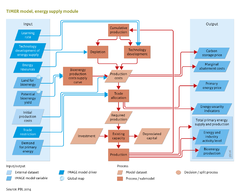Energy supply/Description: Difference between revisions
Jump to navigation
Jump to search
Oostenrijr (talk | contribs) No edit summary |
No edit summary |
||
| Line 66: | Line 66: | ||
The production costs for bioenergy are represented by the costs of feedstock and conversion. Feedstock costs increase with actual production as a result of depletion, while conversion costs decrease with cumulative production as a result of ‘learning by doing’. Feedstock costs include the costs of land, labour and capital, while conversion costs include capital, {{abbrTemplate|O&M}} and energy use in this process. For both steps, the associated greenhouse gas emissions (related to deforestation, N<sub>2</sub>O from fertilisers, energy) are estimated (see Component [[Emissions]]), and are subject to carbon tax, where relevant. | The production costs for bioenergy are represented by the costs of feedstock and conversion. Feedstock costs increase with actual production as a result of depletion, while conversion costs decrease with cumulative production as a result of ‘learning by doing’. Feedstock costs include the costs of land, labour and capital, while conversion costs include capital, {{abbrTemplate|O&M}} and energy use in this process. For both steps, the associated greenhouse gas emissions (related to deforestation, N<sub>2</sub>O from fertilisers, energy) are estimated (see Component [[Emissions]]), and are subject to carbon tax, where relevant. | ||
<div class="version newv31"> | |||
Besides energy crops, Agricultural and forestry residues can also be used as a primary feedstock for modern bioenergy. Residues availability is linked to the productivity of agriculture and forestry, taking into account the effect of changing yields ([[Agricultural economy/Description]]) or [[Forest management]] techniques. The available potential is limited by environmental constraints as well as competing uses (use of Agricultural residues as feed for livestock, see [[Agricultural economy/Description]]). As with bioenergy crops, availability and costs of residues are calculated on a 0.5x0.5 degree grid. For further details see ([[Daioglou et al. 2016]]). | |||
</div> | |||
===Other renewable energy=== | ===Other renewable energy=== | ||
Revision as of 13:14, 18 November 2016
Parts of Energy supply/Description
| Component is implemented in: |
|
| Related IMAGE components |
| Projects/Applications |
| Key publications |
| References |
